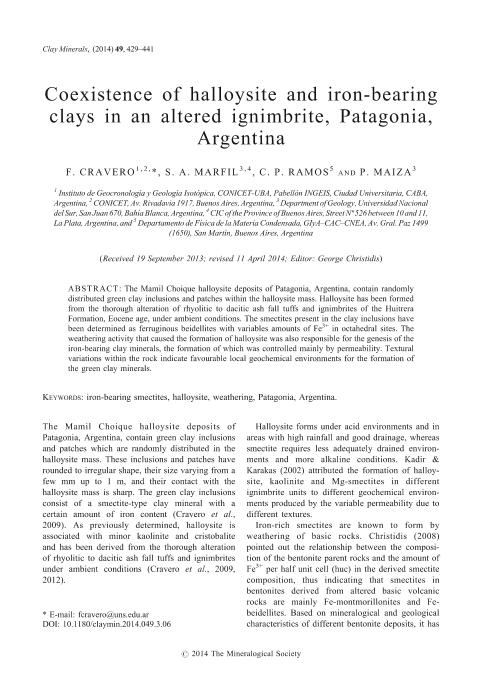Mostrar el registro sencillo del ítem
dc.contributor.author
Cravero, Maria Fernanda

dc.contributor.author
Marfil, Silvina Andrea

dc.contributor.author
Ramos, Cinthia Paula

dc.contributor.author
Maiza, Pedro Jose

dc.date.available
2017-06-16T22:01:37Z
dc.date.issued
2014-06
dc.identifier.citation
Cravero, Maria Fernanda; Marfil, Silvina Andrea; Ramos, Cinthia Paula; Maiza, Pedro Jose; Coexistence of halloysite and iron-bearing clays in an altered ignimbrite, Patagonia, Argentina; Mineralogical Soc; Clay Minerals (print); 49; 3; 6-2014; 429-441
dc.identifier.issn
0009-8558
dc.identifier.uri
http://hdl.handle.net/11336/18393
dc.description.abstract
The Mamil Choique halloysite deposits of Patagonia, Argentina, contain randomly distributed green clay inclusions and patches within the halloysite mass. Halloysite has been formed from the thorough alteration of rhyolitic to dacitic ash fall tuffs and ignimbrites of the Huitrera Formation, Eocene age, under ambient conditions. The smectites present in the clay inclusions have been determined as ferruginous beidellites with variables amounts of Fe3+ in octahedral sites. The weathering activity that caused the formation of halloysite was also responsible for the genesis of the iron-bearing clay minerals, the formation of which was controlled mainly by permeability. Textural variations within the rock indicate favourable local geochemical environments for the formation of the green clay minerals.
dc.format
application/pdf
dc.language.iso
eng
dc.publisher
Mineralogical Soc

dc.rights
info:eu-repo/semantics/openAccess
dc.rights.uri
https://creativecommons.org/licenses/by-nc-sa/2.5/ar/
dc.subject
Iron-Bearing Smectites
dc.subject
Halloysite
dc.subject
Weathering
dc.subject
Patagonia
dc.subject
Argentina
dc.subject.classification
Geología

dc.subject.classification
Ciencias de la Tierra y relacionadas con el Medio Ambiente

dc.subject.classification
CIENCIAS NATURALES Y EXACTAS

dc.title
Coexistence of halloysite and iron-bearing clays in an altered ignimbrite, Patagonia, Argentina
dc.type
info:eu-repo/semantics/article
dc.type
info:ar-repo/semantics/artículo
dc.type
info:eu-repo/semantics/publishedVersion
dc.date.updated
2017-06-16T15:53:34Z
dc.journal.volume
49
dc.journal.number
3
dc.journal.pagination
429-441
dc.journal.pais
Reino Unido

dc.description.fil
Fil: Cravero, Maria Fernanda. Consejo Nacional de Investigaciones Científicas y Técnicas. Oficina de Coordinación Administrativa Ciudad Universitaria. Instituto de Geocronología y Geología Isotopica. Universidad de Buenos Aires. Facultad de Ciencias Exactas y Naturales. Instituto de Geocronología y Geología Isotopica; Argentina
dc.description.fil
Fil: Marfil, Silvina Andrea. Universidad Nacional del Sur. Departamento de Geología; Argentina. Provincia de Buenos Aires. Gobernación. Comisión de Investigaciones Científicas; Argentina
dc.description.fil
Fil: Ramos, Cinthia Paula. Consejo Nacional de Investigaciones Científicas y Técnicas; Argentina. Comision Nacional de Energia Atomica. Centro Atomico Constituyentes; Argentina
dc.description.fil
Fil: Maiza, Pedro Jose. Universidad Nacional del Sur. Departamento de Geología; Argentina. Consejo Nacional de Investigaciones Científicas y Técnicas; Argentina
dc.journal.title
Clay Minerals (print)

dc.relation.alternativeid
info:eu-repo/semantics/altIdentifier/doi/http://dx.doi.org/10.1180/claymin.2014.049.3.06
dc.relation.alternativeid
info:eu-repo/semantics/altIdentifier/url/http://www.ingentaconnect.com/content/minsoc/cm/2014/00000049/00000003/art00006
Archivos asociados
